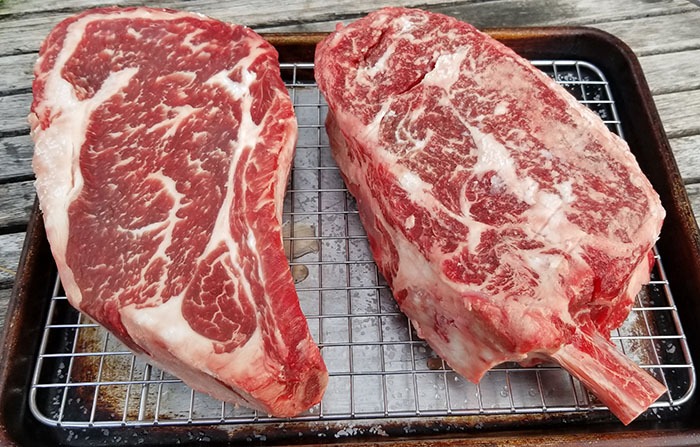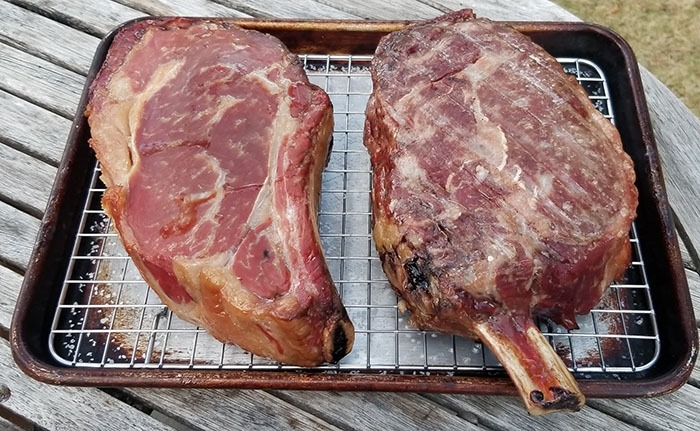Beef Rib Steak Bone-in Dry Aged Pasture S4
I have eaten a few dry aged steaks in my day but have always wanted to practise a next test with a dry anile steak vs. a fresh steak. When I say fresh I don't mean I went to the pasture and hacked off a hunk of the steer. By fresh I just mean a non-dry aged steak.
First off, let's start with a quick explanation of what dry out aged beef is… Dry aged beef is beefiness that has been held for a length of time in a temperature and usually humidity controlled surround. In this time the enzymes in the meat tin alter the texture and flavor of the steak. It unremarkably takes at least 30 days to really beginning to detect a modify in flavor. Most people draw good dry aged steak having the flavors of blue cheese, beingness funky, being bawdy, or something along those lines.
Disclosure: This postal service is monetized with affiliate links. If y'all buy something through them I earn a commission which helps support this site and lets me purchase more meat so I can write about it.
Dry Aged Beef vs. Fresh
Snake River Farms has a great pick of both dry aged and non dry aged beef then I picked up a nice dry aged bone in prime ribeye and a bone in prime ribeye.

The dry aged steak is the 1 on the left and the regular prime number steak is the one on the right. At first look there isn't a ton of deviation in the two. The dry aged steak was a slightly darker color than the regular steak. I really liked the marbling on the non-anile steak but these both had a skilful amount of inter-muscular fat.
Mostly speaking when you dry out age a whole rib primal y'all volition lose some of the coveted cap. Dry aging causes the outer layer of the meat to become tough and inedible. When it is trimmed some of that cap will have to get. You can see the difference in the size of the cap on these two steaks. I have 2 other dry anile steaks that accept a scrap more than cap but zippo like what is on this particular regular steak.
There was as well a scrap of a different scent to the steaks. The dry aged steak smelled a bit funkier than the fresh steak. It wasn't an off smell or any sort of rotten smell simply just a bit nutty, a bit musty, and a fleck funky.
Cooking the Steaks
Well, I approximate it is time to cook these steaks up and encounter what the differences are. I dry out brined the steaks overnight and did a unproblematic reverse sear on my Weber Kettle with my Dull north Sear.

I started with about xv or then lit coals in the corner of my Slow due north Sear and put the steaks on.

When I cook bone in steaks similar this I like to put the bones facing the heat to protect the meat a bit. I endeavour to run my kettle around 225-250 when reverse searing which usually has the height vent closed about half way and the bottom vent only open up a sliver.
A expert reverse sear calls for a good thermometer to measure the temperature of the cooker and the temperatures of the meat. The Thermoworks Smoke X4 has been my go-to thermometer lately.

With 4 channels the Thermoworks Smoke X4 tin measure the temperature of multiple pieces of meat as well every bit the pit. When I cook steaks for my family I usually melt 2 or 3 depending on the size. Every slice of meat is dissimilar so information technology is important to accurately measure the temperature of all the meat.
These two steaks were slightly different sizes so they cooked slightly differently. I usually try to get the steaks upwardly to 115 degrees before I sear. Since these were quite thick it took virtually an hour and a half for the dry aged steak and another 10 minutes for the other.

I pulled them off the heat for a minute or two as I was loading up the Tedious n Sear with a full chimney of hot briquettes for the sear. Some people like to rest the steaks for 10 minutes or so at this point. But I ordinarily sear them right abroad.

When I sear this way I like to flip the steaks every 30 seconds or then. I also like to spin the grate as I cook then I am not putting the steaks dorsum on the super heated grates.

Afterwards but a few minutes the steaks were done and prepare to come off the grill.

After a few minutes of rest it was fourth dimension to eat!
How Unlike Is Dry Aged Steak?
Let's talk virtually these steaks for a infinitesimal. The dry aged steak was ii lbs i oz and the regular prime steak was 2 lbs half-dozen vii/eight ounces. The dry out aged steak cooked a chip quicker than the regular steak and was probably five degrees more than washed than the prime steak.
Hither is a slice of the dry aged steak:

And here is a slice of the prime steak:

There were definitely some textural differences in the two steaks. The regular prime steak had a looser texture. Both steaks were plenty tender but the dry aged steak was just a bit tighter.
Dry aged steaks are known for their funky, blue cheese flavors. There were a few bites of this dry aged steak that had those characteristics. Most of these bites were around the edges. The middle of the steak wasn't as well dissimilar than the regular steak. I noticed the biggest deviation in flavors in the piffling $.25 around the bone. Gnawing on that os was insanely good. Dry out crumbling too makes a big departure in the fatty of the meat. The fattier $.25 did have more than of a funky season than the fat on the regular steak.
Some people aren't a huge fan of the funky flavors of dry out aged steak. Personally I like that flavour. A thirty day dry aged steak similar this one is just starting to develop that funkiness. A 60 or 90 or even 120 day dry anile steak will have a lot more flavor evolution than a thirty twenty-four hours steak.
All in all I loved both of these steaks. The bites that had that developed dry out aged flavor were excellent but overall I didn't call back the dry anile steak had quite enough difference in flavor to justify the toll.
OK, let's talk about cost… This dry aged prime bone in ribeye runs $99 at Snake River Farms. That works out to around $50 per pound. The non-aged prime number os in ribeye (also called a Cowboy Steak) runs about $69 so around $35 per pound. This particular steak was i of the larger ones I have seen so information technology was closer to $28 per pound.
Are the dry anile steaks worth $50 a pound? Peradventure. This is definitely a decadent steak and 1 you would want to save for an important date. A 10th anniversary, a bachelor party, a 50th birthday, or something along those lines would warrant a steak like this. Save this dry aged steak for a special event and splurge.
If yous are ready for a special steak social club your prime bone in dry aged steak from Snake River Farms. And if you but want a "regular" amazing steak go for the prime bone in ribeye.
milliganlighervaing.blogspot.com
Source: https://completecarnivore.com/dry-aged-beef-vs-fresh/
0 Response to "Beef Rib Steak Bone-in Dry Aged Pasture S4"
Post a Comment